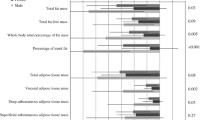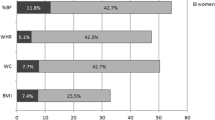Abstract
Because leptin and adiponectin are counter-regulated in vivo and exert opposing effects on glucose metabolism, fat oxidation and insulin sensitivity, the ratio of leptin-to-adiponectin has been investigated as a potential atherogenic index, suggesting that the index is a better biomarker for atherosclerotic risk in obese Type 2 diabetic patients than either leptin or adiponectin alone. However, no information is available regarding the leptin-to-adiponectin ratio during adolescence in Hispanic adolescents. Therefore, the present study was designed to investigate the leptin-to-adiponectin ratio during growth and to establish whether the leptin-to-adiponectin ratio is a better predictor for insulin sensitivity compared to leptin and adiponectin alone in a regression model. From the age of 8 to 14, the leptin-to-adiponectin ratio increased from 2.0±0.8 to 5.8±2.2 in girls, with no significant change noted in boys (gender × age interaction p = 0.007). In a multiple regression analysis, including both adiponectin and leptin as independent variables, leptin and adiponectin explained 5% of the variation in insulin sensitivity independent of gender, age, Tanner stage, total fat mass and lean body mass (p for R2-change <0.001). The leptin-to-adiponectin ratio also explained 5% of the variation in insulin sensitivity, after controlling for the same covariates (p for R2-change < 0.001). These data indicate that the leptin-to-adiponectin ratio is not a better predictor of insulin sensitivity during growth than the additive effects of leptin and adiponectin levels.
Similar content being viewed by others
References
Ceddia RB. Direct metabolic regulation in skeletal muscle and fat tissue by leptin: implications for glucose and fatty acids homeostasis. Int J Obes (Lond) 2005, 29: 1175–83.
Weyer C, Funahashi T, Tanaka S, et al. Hypoadiponectinemia in obesity and Type 2 diabetes: close association with insulin resistance and hyperinsulinemia. J Clin Endocrinol Metab 2001, 86: 1930–5.
Kratzsch J, Lammert A, Bottner A, et al. Circulating soluble leptin receptor and free leptin index during childhood, puberty, and adolescence. J Clin Endocrinol Metab 2002, 87: 4587–94.
Fleisch AF, Agarwal N, Roberts MD, et al. Influence of serum Leptin on weight and body fat growth in children athigh risk for adult obesity. J Clin Endocrinol Metab 2007, 92: 948–54.
Bottner A, Kratzsch J, Muller G, et al. Gender differences of adiponectin levels develop during the progression of puberty and are related to serum androgen levels. J Clin Endocrinol Metab 2004, 89: 4053–61.
Kotani K, Sakane N, Saiga K, Kurozawa Y. Leptin: adiponectin ratio as an atherosclerotic index in patients with type 2 diabetes: relationship of the index to carotid intima-media thickness. Diabetologia 2005, 48: 2684–6.
Satoh N, Naruse M, Usui T, et al. Leptin-to-adiponectin ratio as a potential atherogenic index in obese type 2 diabetic patients. Diabetes Care 2004, 27: 2488–90.
Diamond FB Jr, Cuthbertson D, Hanna S, Eichler D. Correlates of adiponectin and the leptin/adiponectin ratio in obese and non-obese children. J Pediatr Endocrinol Metab 2004, 17: 1069–75.
Goran MI, Bergman RN, Avila Q, et al. Impaired glucose tolerance and reduced beta-cell function in overweight Latino children with a positive family history for type 2 diabetes. J Clin Endocrinol Metab 2004, 89: 207–12.
Cruz ML, Weigensberg MJ, Huang TT, Ball G, Shaibi GQ, Goran MI. The metabolic syndrome in overweight Hispanic youth and the role of insulin sensitivity. J Clin Endocrinol Metab 2004, 89: 108–13.
Centers for Disease Control and Prevention. CDC growth Charts. In: U.S. Department of Health and Human Services Cf DCaP, ed.: National Center for Health Statistics, 2000.
American Diabetes Association. Type 2 diabetes in children and adolescents. Pediatrics 2000, 105: 671–80.
Weigensberg MJ, Ball GD, Shaibi GQ, Cruz ML, Goran MI. Decreased beta-cell function in overweight Latino children with impaired fasting glucose. Diabetes Care 2005, 28: 2519–24.
Yamauchi T, Kamon J, Waki H, et al. The fat-derived hormone adiponectin reverses insulin resistance associated with both lipoatrophy and obesity. Nat Med 2001, 7: 941–6.
Author information
Authors and Affiliations
Corresponding author
Rights and permissions
About this article
Cite this article
Koebnick, C., Shaibi, G.Q., Kelly, L.A. et al. Leptin-to-adiponectin ratio as independent predictor of insulin sensitivity during growth in overweight Hispanic youth. J Endocrinol Invest 30, RC13–RC16 (2007). https://doi.org/10.1007/BF03346344
Accepted:
Published:
Issue Date:
DOI: https://doi.org/10.1007/BF03346344




